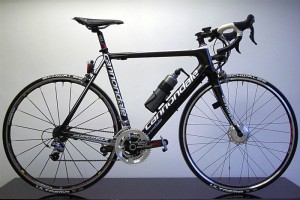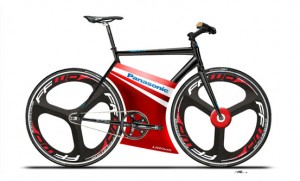I post about e-bikes from time to time, and I am definitely a fan of the category. I believe that urban oriented e-bikes, like the Sanyo Eneloop, have potential to get more people riding, and that is definitely a good thing. Longtails and cargo bikes are another type of bike that I really think could really benefit from the addition of an electric motor (this electric Kona Ute from Interbike is a good example). Pedal assist could extend the usefulness of those types of bikes for many potential users.

Lately though, I have been thinking a bit about a different type of electric bike. I mentioned in a recent discussion thread about e-bikes for commuting on the LinkedIn “World Cycling Industry” group that electric assist might be nice for a short stretch of my commute. One section of my ride to work is on a busy, narrow two-lane road with rolling hills. When I get to that section, I usually get down in the drops and pedal hard to get through it as quickly as I can. I like to maintain a speed of at least 25 mph through that section, but that is not always easy to do on a loaded bike after a long day at work (especially in the winter). In that situation, it might be nice to have a small reserve motor to help me maintain speed until I get to a road with less traffic.
Obviously, a comfort-oriented bike would not be the solution for me. I would prefer something lightweight with road bike geometry and just enough reserve for the few times that I want to use it. In the discussion thread, Juan Diaz mentioned Cytronex bikes, which use fairly small NiMH batteries and have a throttle for that occasional punch when needed. He also mentioned the BH Emotion bikes based on the Panasonic mid drive motor. Another option for a lightweight (relatively speaking of course) e-bike is the electric conversion kit from Freedom e-bikes. According to the website, the kit is only a 3.2kg weight (about 7lb) addition to a regular bike. My current commuting bike (an older Litespeed) is just over 20 pounds with racks, so I could turn it into a sub 30-pound e-bike with the conversion from Freedom. I probably never will, but it is something I would like to try… mainly out of curiosity.

Coincidentally, Henry Chong sent me his e-bike concept (pictured here) as I was starting to assemble links for this post. Last year, I briefly mentioned the Trek Phase, another concept e-bike that seemed to be targeted more toward the current base of enthusiasts than new cyclists. As the e-bike category matures (here in the U.S. at least), I think we will continue to see electric bike designs that are geared toward different segments of the market. So I am curious…would you ever consider an electric bike for your commute? If so, what type of bike (or features) would you want?

Leave a Reply